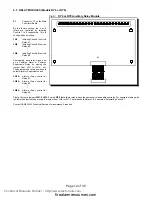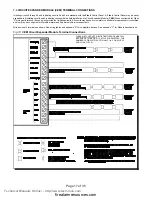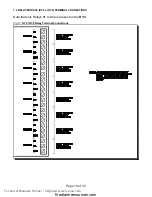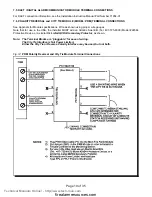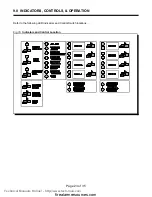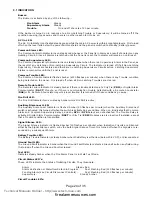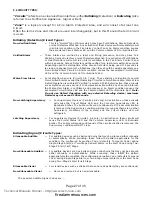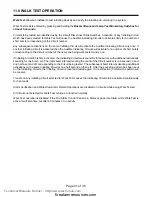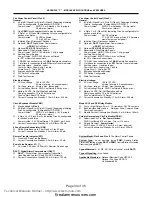
Page 26 of 35
9.2 CONTROLS:
System Reset Switch:
The System Reset momentary switch causes the Fire Alarm Control Panel, and all Circuits, to be reset ...
Resets all Latching Trouble Conditions
Resets all Initiating Circuits
Interrupts the 4-Wire Detector Supply
Turns off all Indicating Circuits
Turns off Signal Silence Indicator
Turns off Fire Drill
Stops and resets all Timers
Processes inputs as new events
Aux Disconnect not affected
Signal Silence Switch:
Activation of the Signal Silence momentary switch when the Panel is in Alarm turns on the Signal Silence
Indicator and deactivates any Silenceable Indicating Circuits. Non-Silenceable Circuits are unaffected. Signals
will re-sound upon any subsequent Alarm. This switch does not function during any configured Signal Silence
Inhibit Timer period. It also does not function if the Indicating Circuits are active as the result of a Fire Drill.
Fire Drill Switch:
The Fire Drill momentary switch activates all non-Disconnected Indicating Circuits, but does not transmit any
Alarms via the Dialler, City Tie, or Common Alarm Relay, nor are any
RY4
or
RY8
Relays activated. Fire Drill
is cancelled by activating the switch again, or if the Panel goes into a real Alarm.
Auxiliary Disconnect Switch:
Activating the Auxiliary Disconnect momentary switch activates the Auxiliary Disconnect function. Activating
the switch again de-activates the function. When Auxiliary Disconnect is active, Common Alarm and Common
Supervisory Relays, and any
RY4
/
RY8
Relays are not activated. The Trouble Relay is activated. Digital Alarm
Communicator (
DACT
) or City Tie Modules (
PRM
) are also inactive if installed, except that a Trouble condition
is transmitted.
Lamp Test Switch:
Activation of the Lamp Test momentary switch turns all front panel Indicators and the buzzer on.
Buzzer Silence Switch:
Activation of the Buzzer Silence momentary switch while the Buzzer is sounding silences the Buzzer. The
Buzzer will resound if there is a subsequent event.
Circuit Disconnect Switches:
Activation of these non-momentary switches disconnects the respective Initiating Circuit, and causes a Circuit
Trouble for that Initiating Circuit while active. If the disconnect switch is turned off (to its normal position) while
there is an Alarm condition in that circuit, the respective circuit Status LED will flash at a rate of 120 flashes per
minute to indicate a Pending Alarm, for 5 seconds. If the disconnect switch is not turned back on, an Alarm will
be processed normally.
9.3 OPERATION:
All Alarm inputs are treated in a similar manner. Alarm inputs include Non-Verified or Verified Alarms, and Water-
flow Alarms. Any of these Alarm inputs occurring when the Panel is not already in Alarm cause the following:
Ž
The Buzzer sounds steadily
Ž
If Fire Drill is active, it is cancelled
Ž
The Common Alarm Indicator turns on
Ž
The Common Alarm Relay activates if Aux Disconnect is not active
Ž
The Auto Signal Silence Timer, if configured, starts
Ž
The Signal Silence Inhibit Timer, if configured, starts
Ž
RY4 / RY8 Relays are activated as configured, provided that Aux Disconnect is not active
Ž
Signals and Strobes are activated
Subsequent Alarms when the Panel is already in Alarm, cause the following:
Ž
The Buzzer sounds steadily
Ž
If Signals have been silenced as a result of the Signal Silence button or the Auto Signal Silence Timer, Signals are resounded as they were
before Signal Silence, the Signal Silence Indicator is turned off, and the Auto Signal Silence Timer, if configured, is restarted
Ž
Signals and Strobes are activated
Technical Manuals Online! - http://www.tech-man.com
firealarmresources.com

